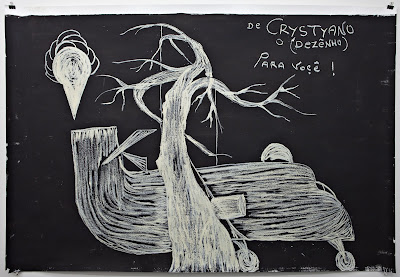 |
|
Agatha Wojciechowsky, untitled, undated, chalk on paper, 60.5 x 45.3 cm |
Accrochage at the Gallery from October 28th, 2020 with works from Agatha Wocjciechowsky, Helga Goetze and Alexandru Chira. Stop by to see it!
Agatha Wojciechowsky was born in 1896, in Steinach, Germany. According to her own statement she experienced her first visions at the age of four. In 1923 she emigrated to the United States, where she worked as a maid, a seamstress, a laundress, and a kitchen helper in various hotels. After World War II, she became a well-known spiritual medium and a healer to a small circle of insiders. In 1951, she began to draw countless mediumistic drawings in which eerie spectral faces can be perceived through a maze of abstract forms and graphic symbols. “Mona”, the ghost of an American Indian girl, appeared to her one day and she began to draw according to Mona's instructions: “Take a small pencil, place it on a sheet of paper and watch what happens, immediately it, and I, began to draw and we drew and drew for a long time”. This is how Agatha Wojciechowsky describes the beginning of her artistic activity.
Helga Goetze (* 1922 Magdeburg, Germany, † 2008 Winsen, Germany), also known as Helga Sophia, was a German artist, writer and political activist, who lived and worked in Hamburg and Berlin. In 1972 she founded the Institute for Sex Information and published her first poetry collection Hausfrau der Nation oder Deutschlands Supersau (Housewife of the Nation or Germany’s Super Sow). Later on, Goetze kept close contact with the commune founded by the Vienna performance artist Otto Mühl and was actively associated with the Hamburg cultural centre “Fabrik”. After moving to Berlin in 1978, the artist started to maintain daily protest pickets in favour of women’s sexual liberation in front of the Technical University as well as the Berlin Gedächtniskirche. In Berlin, she also founded the “Geni(t)al University”, a gallery and open museum. Conversations with Rosa von Praunheim inspired her to make the film Rote Liebe (Red Love) in 1982. With the 1982 TV show Neue Nackte, neue Einsichten (New Nudes, New Insights), where she undressed in front of the camera, and several appearances on TV talk shows during the 1990ies, Goetze challanged the public debate around sexuality in the media. In 2000, she founded the association Metropole Mutterstadt e.V. (Metropolis Mother City) with a group of friends and in 2003, Monika A. Wojtyllo made a film about the artist, titled Sticken und Ficken (Embroidery and Fucking).
Alexandru Chira (1947, Tauseni, Romania - 2011, Bucharest, Romania), who was native of a small village in Transilvania, realized that the new idols of mechanized agriculture (tractors, threshers etc.) proved inefficient when faced with the tough limits of nature - his home village suffered of yearlong drought. Chira started to elaborate a sophisticated system of land-and-weather improving art equipment, a series of staggering, symbolic installations of painted metal, wire, and concrete. Their task was "to bring rain and rainbow", to convey prosperity, and prevent deluge. Later on, during the 1990s, already a university professor and acclaimed artist, Chira succeeded in accomplishing his lifelong dream: the ensemble in Tauseni, the biggest one-man-monument in Transylvania. Most of his prior (and later) works, either those on canvas or the drawings and objects are inspiring sketches or derivative works related to the monument. Maturing his art-agrarian fascination for decades, the monomaniac Chira deepened in the diverse branches of practical knowledge and spiritual speculation requested by such a bold plan. Architecture, design, astronomy, history, magic, UFO-logy, mysticism, shamanism, and theosophy conjoined in an effort to strengthen the material and immaterial assets of the project. Nothing is left to chance in his painted graphs. Their apparent visual geomancy is grounded on a peculiar conjunction of human will, sheer transcendence, and natural forces.


